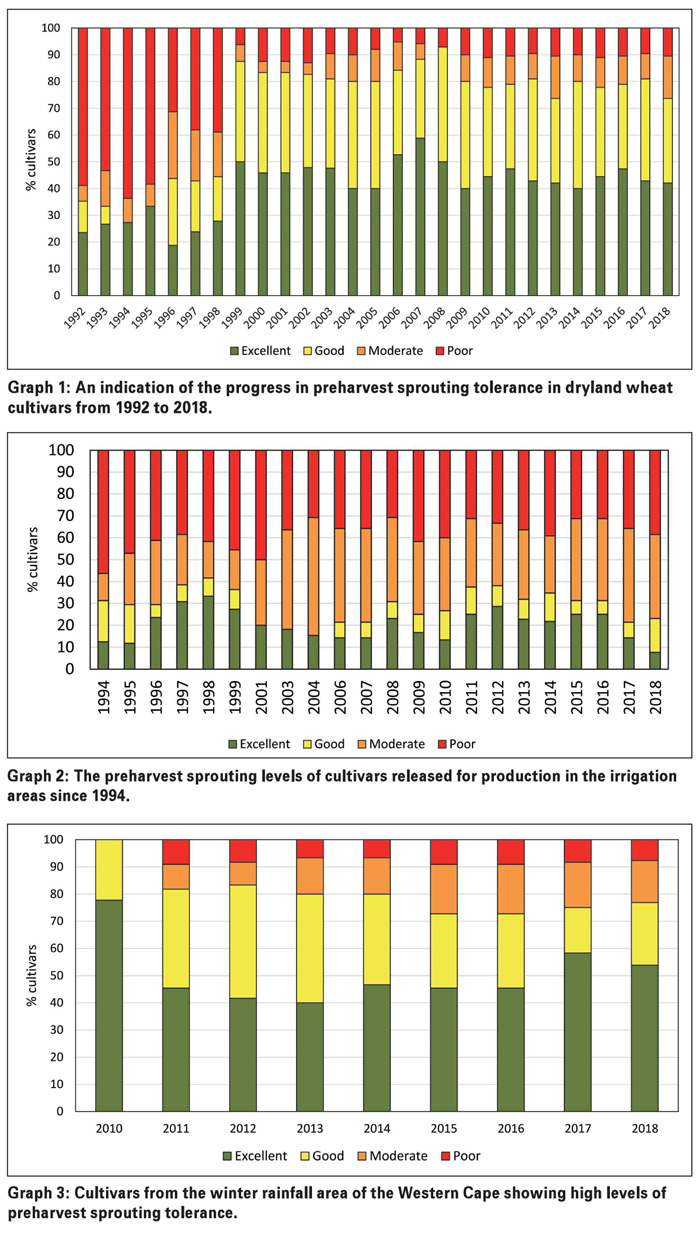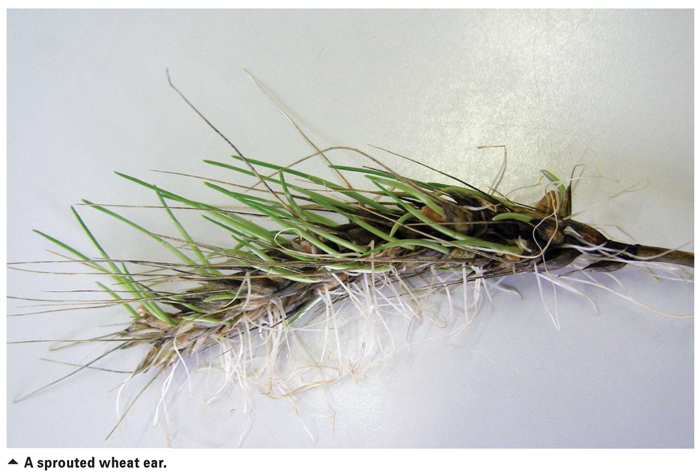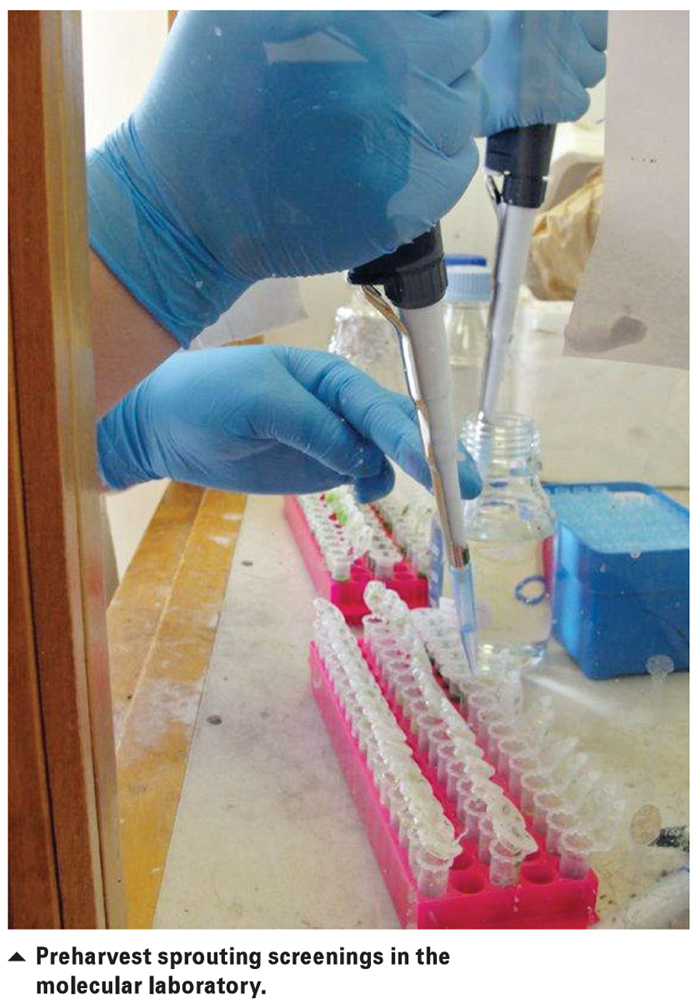October 2018
 Preharvest sprouting in wheat is the result of continuous rainfall just prior to or during harvest time. The net result of such sprouting is the formation of excess alpha-amylase, along with other enzymes, which renders the wheat flour unsuitable for use in food products.
Preharvest sprouting in wheat is the result of continuous rainfall just prior to or during harvest time. The net result of such sprouting is the formation of excess alpha-amylase, along with other enzymes, which renders the wheat flour unsuitable for use in food products.
Until 1997 the wheat industry in South Africa was characterised by a single marketing channel and was controlled by a centralised Wheat Board who fixed wheat prices and controlled imports and exports. The deregulation of the Wheat Board in 1998 has led to various changes, including the introduction of the falling number method, which is widely used to estimate alpha-amylase activity in wheat grain, as part of the South African grading regulations.
Wheat producers in South Africa were confused by this new method which was included in the quality description of wheat sold by producers. The test was incorporated within the South African wheat grading regulations, without prior testing or impact studies being performed. Before its incorporation, wheat was indirectly evaluated for low falling number through a visual screening test that required that a 25 g wheat sample should not contain more than 2% sprouted wheat.
Initially a minimum of 250 sec falling number were required for the highest grade. It soon, however, became obvious that various factors, other than sprouted wheat, had an influence on the falling number of wheat, as numerous reports of low falling number wheat without visual sprouting were received throughout the summer rainfall wheat producing areas of South Africa, resulting in enormous financial implications for the producers.
Once the lack of stability of the test was realised, a 30 sec grace fraction was implemented that stipulated that a falling number minimum of 220 sec is required to obtain grade B1 to B3, depending on the protein content and hectolitre mass. A falling number of 200 sec is required for grade 4, with wheat being downgraded to utility grade if the falling number is below 150 sec.
 Even with the new regulations in place, producers continued to experience problems with the test, which was voiced to ARC-Small Grain. Research into the various factors, aside from high alpha-amylase activity as a result of sprouting that might contribute to low falling number, was therefore necessitated. Intensive trials were executed in order to justify the necessity of the falling number system as part of the grading regulations.
Even with the new regulations in place, producers continued to experience problems with the test, which was voiced to ARC-Small Grain. Research into the various factors, aside from high alpha-amylase activity as a result of sprouting that might contribute to low falling number, was therefore necessitated. Intensive trials were executed in order to justify the necessity of the falling number system as part of the grading regulations.
Many wheat producing areas in South Africa, especially the Eastern Free State, are highly subjected to the risk of preharvest sprouting due to summer rainfall that occurs just prior to or during harvest. Since preharvest sprouting is closely related to falling number, a lot of effort and energy were put into preharvest sprouting research over the past 20 years.
 The impact of preharvest sprouting damage on the wheat industry in South Africa has been well documented. Following the initiation of a selection and research programme aimed at combatting susceptibility to preharvest sprouting damage in the early 1990s, various methods to minimise the damaging effects of preharvest sprouting, were investigated.
The impact of preharvest sprouting damage on the wheat industry in South Africa has been well documented. Following the initiation of a selection and research programme aimed at combatting susceptibility to preharvest sprouting damage in the early 1990s, various methods to minimise the damaging effects of preharvest sprouting, were investigated.
Research has shown than the genotypic variation in preharvest sprouting in South African cultivars is dominant, indicating that progress in the development of cultivars with sprouting tolerance is feasible. During the past decades, the development of wheat cultivars with high levels of seed dormancy has been an objective of all breeding companies in South Africa.
Preharvest sprouting results of commercial cultivars are available since 1991. Over the past 27 years more than 150 wheat cultivars of the three breeding institutions have been evaluated for their preharvest sprouting resistance.
Significant progress has been made with the release of especially winter wheat cultivars with high levels of preharvest sprouting tolerance from only 23% of cultivars, showing tolerance in the early 1990s to almost 60% currently (Graph 1).
Research clearly showed that South African winter wheat cultivars can be categorised into three major groups, namely those that are highly resistant to preharvest sprouting and others that are highly susceptible. The third group includes cultivars that are strongly influenced by the environment and includes both ‘good’ and ‘moderate’ types.
Without reference to individual cultivars, Graph 1 gives a good indication of the progress that has been made in the development of winter wheat cultivars with high levels of preharvest sprouting tolerance over the past 20 years. This graph shows the preharvest sprouting groupings of all the commercial cultivars that were evaluated and included in the ARC-Small Grain Annual Production Guidelines in a specific year.
Commercial cultivars were evaluated for their preharvest sprouting tolerance and the preharvest sprouting value that each cultivar received, is the average of 120 individual ears over three different localities. According to the values, cultivars were grouped into either ‘excellent’, ‘good’, ‘moderate’ or ‘poor’ groupings. These groups are then given a percentage depending on the number of cultivars evaluated in that specific year.
The preharvest sprouting evaluation programme was initiated at the beginning of the 1990s. During this time most of the dryland wheat cultivars had poor preharvest sprouting tolerance. This is shown by the red colour of the bars in Graph 1.
As a result of continuous evaluations and adaptations to the respective breeding programmes, the preharvest sprouting tolerance of cultivars improved significantly to such an extent that only two out of the 19 cultivars (10,5%) that are currently commercially available, have poor preharvest sprouting tolerance compared to the almost 60% in 1992.
Similar to the dryland cultivars, more than 20 years of preharvest sprouting data are available for irrigation cultivars. Graph 2 shows the percentage of cultivars with ‘excellent’, ‘good’, ‘moderate’ or ‘poor’ preharvest sprouting tolerance respectively for each year from 1994 to 2018.
The number of cultivars with poor preharvest sprouting tolerance (indicated by red bars) has also decreased over the last 20 years from almost 58% in 1994 to 38% in 2018 (Graph 2). However, the number of cultivars with excellent preharvest sprouting tolerance (green bars) is still very low. The majority of current commercial cultivars either has good or moderate preharvest sprouting tolerance.
Unlike the higher levels of preharvest sprouting tolerance in dryland cultivars, it has been shown over many years that cultivars grown under irrigated conditions do not display the same levels of tolerance. A possible reason for this might be that the dormancy of cultivars grown under irrigation conditions is not as high as under dryland conditions. Previous research has shown that a reduction in dormancy can occur when water supply was high during the later stages of grain filling. Therefore, the sufficient supply of water at critical growth stages might reduce dormancy, possibly explaining the lower levels of preharvest sprouting observed in irrigation cultivars where moisture stress is not a factor.
Preharvest sprouting evaluation of cultivars in the Western Cape production area is relatively new and only nine years of data are available. It is evident, however, that the cultivars released for production in the winter rainfall area, in contrast to the cultivars under irrigation, have a very good tolerance to preharvest sprouting. Graph 3 gives an indication of the preharvest sprouting levels of cultivars released for production in the Western Cape.
From this graph it is clear that the majority of cultivars have an excellent to good tolerance to preharvest sprouting. This is indicated by the green and yellow bars respectively in the graph. Between 70% and 80% of the commercially available cultivars tend to have a good to excellent preharvest sprouting tolerance.
Tolerance to preharvest sprouting involves an interaction between genes and the environment. This means that certain cultivars, especially those in the ‘good’ and ‘moderate’ groups can show tolerance to preharvest sprouting in one year, while the tolerance can be significantly lower in the following year.
The temperatures that wheat is exposed to during the critical grain filling period, may also have an effect on the dormancy of certain cultivars. Dormancy is usually higher when temperatures during grain filling are low, while high temperatures during grain filling shortens the dormancy period. Therefore, cultivars which are influenced by the environment, might show various levels of preharvest sprouting from year to year as a result of varying temperatures between seasons.
More recently, preharvest sprouting research has moved into a more molecular direction to enhance pre-breeding for preharvest sprouting. Molecular markers are used to compare marker haplotype combinations with the original preharvest sprouting cultivar scoring averages.
 These marker haplotypes will most probably be used in future to predict the potential preharvest sprouting tolerant class of a cultivar. This marker technology is meant to compliment the phenotypic screening and make the breeding or selection for preharvest sprouting tolerance more efficient.
These marker haplotypes will most probably be used in future to predict the potential preharvest sprouting tolerant class of a cultivar. This marker technology is meant to compliment the phenotypic screening and make the breeding or selection for preharvest sprouting tolerance more efficient.

Publication: October 2018
Section: On farm level